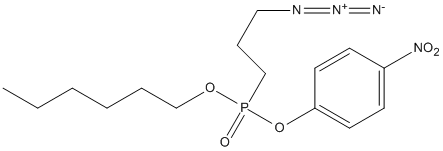ABP-C6
General
Type : pNP,Organophosphate,ABPP-Probe,Azido
Chemical_Nomenclature : Hexyl 4-nitrophenyl (3-azidopropyl)phosphonate
Canonical SMILES : CCCCCCO[P](=O)(OC1=CC=C(C=C1)[N+](=O)[O-])CCCN=[N+]=[N-]
InChI : InChI=1S\/C15H23N4O5P\/c1-2-3-4-5-12-23-25(22,13-6-11-17-18-16)24-15-9-7-14(8-10-15)19(20)21\/h7-10H,2-6,11-13H2,1H3
InChIKey : ZLYCUFAZUOTXBM-UHFFFAOYSA-N
Other name(s) : ABP C6
MW : 370.14
Formula : C15H23N4O5P
CAS_number :
PubChem :
UniChem : ZLYCUFAZUOTXBM-UHFFFAOYSA-N
IUPHAR :
Wikipedia :

Target
Families : ABP-C6 ligand of proteins in family: Hormone-sensitive_lipase_like || Monoglyceridelipase_lysophospholip || ABHD11-Acetyl_transferase || Carb_B_Chordata || A85-EsteraseD-FGH || LYsophospholipase_carboxylesterase || PPase_methylesterase_euk || ACPH_Peptidase_S9 || CGI-58_ABHD5_ABHD4 || Arylacetamide_deacetylase || BCHE || Prolylcarboxypeptidase || DPP4N_Peptidase_S9 || PC-sterol_acyltransferase
Stucture :
References (2)
| Title : Spatially resolved activity-based proteomic profiles of the murine small intestinal lipases - Schittmayer_2020_Mol.Cell.Proteomics_19_2104 |
| Author(s) : Schittmayer M , Vujic N , Darnhofer B , Korbelius M , Honeder S , Kratky D , Birner-Gruenberger R |
| Ref : Mol Cell Proteomics , 19 :2104 , 2020 |
| Abstract : Schittmayer_2020_Mol.Cell.Proteomics_19_2104 |
| ESTHER : Schittmayer_2020_Mol.Cell.Proteomics_19_2104 |
| PubMedSearch : Schittmayer_2020_Mol.Cell.Proteomics_19_2104 |
| PubMedID: 33023980 |
| Title : A robust and simple protocol for the synthesis of arylfluorophosphonates - Leypold_2015_Tetrahedron.Lett_56_5619 |
| Author(s) : Leypold M , Wallace PW , Kljajic M , Schittmayer M , Pletz J , Illaszewicz-Trattner C , Guebitz GM , Birner-Gruenberger R , Breinbauer R |
| Ref : Tetrahedron Letters , 56 :5619 , 2015 |
| Abstract : Leypold_2015_Tetrahedron.Lett_56_5619 |
| ESTHER : Leypold_2015_Tetrahedron.Lett_56_5619 |
| PubMedSearch : Leypold_2015_Tetrahedron.Lett_56_5619 |
| PubMedID: |